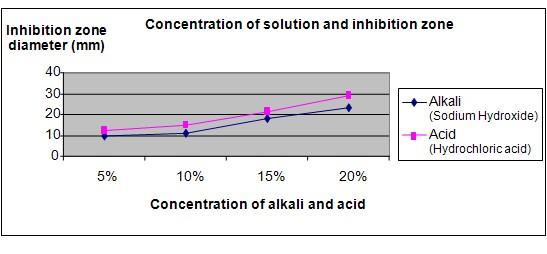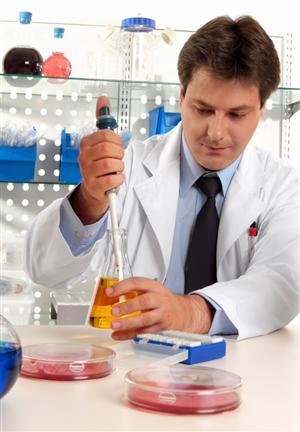| Complexity level: | 6 |
| Project cost ($): | 50 |
| Time required: | Preparation will require one day, while observation and recording of data will be carried out over a period of three days |
| Material availability: | Easily found |
| Safety concerns: | The bacteria should be destroyed with bleach before it is disposed of. Gloves and protective eyewear must be worn when handling the acid and alkali. |
Hypothesis
A higher concentration of acidic and alkaline solutions will result in a larger inhibition zone.
Overview
Bacteria
Bacteria are small single-cellmicroorganisms that exist in almost all parts of the world. They can be found in the soil, our body, the earth’s crust, radioactive waste and even the acidic water in hot springs. Bacteria measure only a few micrometers in size, and they are found to have a variety of sizes and shapes such as spirals, rods and spheres.
The majority of the bacteria around us are harmless, and some of them are even necessary for our survival. These beneficial bacteria exist in our body, and can be found in areas such as our stomach and intestine. An example of such bacteria is the species E. coli that aids digestion. . However, there are some types of bacteria that spread diseases and cause people to become ill. These bacteria are known as pathogens. Hence, it is crucial for us to maintain proper personal hygiene and a clean and safe environment through the use of disinfectants.
Temperature, oxygen availability, pH, salt concentration and nutrient availability are factors that influence the growth and reproduction of most species of bacteria. The optimum temperature for most bacteria to survive and grow ranges from 25 degrees Celsius to 40 degrees Celsius, and the optimum pH levels ranges from 6 to 8. However, some bacteria are able to mutate and evolve to survive under inhospitable environments.
Scientific Terms
Materials
Materials required for this science fair project:
- 8 agar Petri dishes prepared with agar
- 8 disinfected swabs
- 1 bottle of disinfected water
- 1 filter paper
- 1 hole puncher
- 9 test tubes and a rack
- 1 measuring cylinder
- 1 bottle of hydrochloric acid
- 1 bottle of Sodium hydroxide
- E. coli. bacteria culture
- A pair of forceps
- 1 marker pen
- A pair of gloves
Procedure
1. The independent variables in this science fair project are the concentration of sodium hydroxide (alkaline) and hydrochloric acid (acid) – 5%, 10%, 15% and 20%. The dependent variable is the size of inhibition zone (area free of bacteria), which is determined by measuring the diameter of the area using a ruler. The constants (control variables) are the temperature of the room, the amount of sunlight and the ingredients used to make the agar in the Petri dishes.
2. Use the marker pen to label eight Petri dishes that were prepared with agar as acid 5%, acid 10%, acid 15%, acid 20%, alkaline 5%, alkaline 10%, alkaline 15% and alkaline 20%. Store the eight Petri dishes in a refrigerator.
3. Before the start of the experiment, take three Petri dishes out of the refrigerator and allow them to warm up to room temperature.
4. Use eight test tubes to prepare different concentrations of alkaline and acidic solutions, and label them accordingly as stated below. Note that gloves should be worn when handling the acid and alkali.
a. 5% - 5 ml sodium hydroxide or hydrochloric acid mixed with 95 ml of water
b. 10% - 10 ml sodium hydroxide or hydrochloric acid mix with 90 ml of water
c. 15% - 15 ml sodium hydroxide or hydrochloric acid mix with 85 ml of water
d. 20% - 20fml sodium hydroxide or hydrochloric acid mix with 80 ml of water
2. Use the ninth test tube to mix 40 ml of disinfected water with 10 ml of E. coli bacteria culture.
3. Use the hole puncher to cut 40 circular discs out of the filter paper. Label the discs as 5%, 10%, 15% and 20%. Note that each label will have 10 discs ie there should be 10 discs marked 5%, 10 marked 10% and so on and so forth.
4. Rinse the swab with disinfected water before dipping it into the test tube containing the solution of bacteria culture. Rub the swab gently against the entire agar surface in each of the 8 Petri dishes. Next, use the forceps to pick up and immerse each punched and labeled filter paper into the test tube that contains the corresponding concentration of sodium hydroxide or hydrochloric acid according to the labels made earlier. For each of the four sets of labeled filter paper, five circular discs will be immersed in the alkaline solution and placed in the Petri dishes labeled as alkali, while the remaining five circular discs will be immersed in the acidic solution and placed in the Petri dishes labeled as acid. The placement of each set of filter paper onto its corresponding Petri dish is done according to the labels made earlier.
5. Keep the Petri dishes in a cool and shaded place for the next three days. This is to allow the bacteria to grow.
6. Observe the Petri dishes after 3 days. There will be a circular area around the disk without any bacterial growth, which is called the inhibition zone. Use a ruler to measure the diameter of the inhibition zone in each Petri dish and calculate the average value. Record the measurement in the table given below.

Results
Acidic and alkaline solutions of a higher concentration were obs
It was also observed that the acidic solution led to a larger inhibition zone compared to the alkali solution of the same concentration.
| Solution used | Diameter of the inhibition zone (mm) | |||
| 5% | 10% | 15% | 20% | |
| Alkali (Sodium Hydroxide) | 10 | 11 | 18 | 23 |
| Acid (Hydrochloric acid) | 12 | 15 | 21 | 29 |
Use the graph below to plot the experimental data recorded in the table above.

Conclusion
The experimental data and analyzed results support the hypothesis that higher concentrations of acidic and alkaline solutions will result in a larger inhibition zone. Acidic solutions were also proven to be more effective than alkaline solutions in eliminating bacteria, which is shown by the larger inhibition zone in the Petri dishes that were treated with acid.
Bacteria are single-celled organisms that can be found almost everywhere in the world. They are all around us, and some of them are even living inside our body. Although most bacteria are harmless, bacteria that are grouped under pathogens can be deadly, and will cause diseases such as tuberculosis, cholera, typhoid and leprosy.
Also consider
Try to repeat this science fair project using other types of acids such as sulfuric acid or alkali such as calcium carbonate.
The experiment can be repeated using other species of bacteria such as the Cocci, Spirilla or Vibro.
References
Bacteria - http://en.wikipedia.org/wiki/Bacteria
Introduction to bacteria - http://www.umsl.edu/~microbes/introductiontobacteria.pdf

